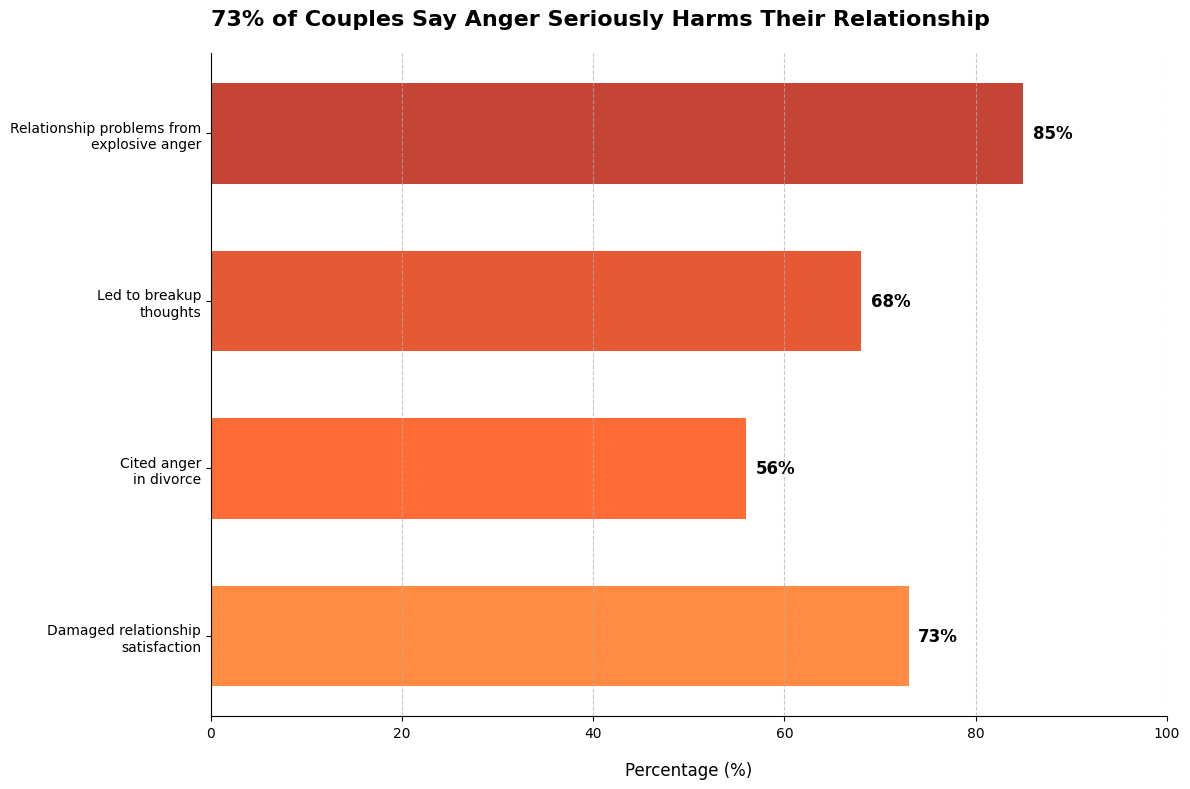How to Control Anger in a Relationship Before It's Too Late: Your 5-Stage Recovery Map
Rod Mitchell, MSc, MC, Registered Psychologist
Key Highlights
Anger in relationships is often a misunderstood attempt at connection, not destruction.
You have a 6-20 second window to intervene before anger hijacks your brain - using the STOP protocol (Stop, Take a breath, Observe, Proceed) within this window prevents escalation.
Your attachment style creates a specific "anger fingerprint" that determines your triggers and reactions.
The specialists at our anger management Calgary clinic find that co-regulation works better than going it alone - your partner's calm nervous system can literally help regulate yours during conflict.
What if your anger could become the bridge to deeper connection instead of the wall that divides you? When frustration flares in your relationship, it often feels like you're trapped in a cycle where every disagreement escalates, leaving both partners feeling misunderstood and alone.
Learning how to control anger in a relationship isn't about suppressing your emotions or walking on eggshells - it's about transforming those intense moments into opportunities for genuine intimacy and understanding. In this comprehensive guide, you'll discover a proven 5-stage transformation framework that helps couples move from reactive conflict to conscious connection.
For new parents experiencing relationship strain alongside intense emotions, our guide "Postpartum Anger: Your Body's Overlooked Survival Signal (And How to Reset It)" addresses how hormonal changes can intensify anger and impact partnerships during this vulnerable period. To better understand your specific anger patterns before applying relationship strategies, see our comprehensive guide "Types of Anger: The Complete Guide to Recognizing & Managing Your Pattern".
Table of Contents Hide
Anger's impact on relationships is stark - from damaging daily satisfaction to triggering divorce considerations. The majority of couples report serious relationship consequences from unmanaged anger, with explosive anger causing relationship problems in 85% of cases.
How to Control Anger in a Relationship: Your Starting Point
What if anger isn't the enemy in your relationship - but a misunderstood messenger trying to bring you closer together?
When you're in the heat of an argument with your partner, feeling your heart race and words sharpen, anger feels anything but connective. Yet groundbreaking research reveals something remarkable: anger in relationships is often a desperate attempt at connection, not destruction.
Dr. Sue Johnson, developer of Emotionally Focused Therapy, explains: Anger is often a secondary emotion that masks primary emotions like hurt, fear, or longing for connection. When we help people access what's underneath the anger - the attachment injury or the fear of disconnection - we see remarkable shifts.
Think of this guide as your relationship GPS. When your usual route hits construction or traffic, your GPS doesn't judge you for taking the wrong turn - it simply recalculates and shows you a new path forward.
Understanding Your Starting Point
This guide is for you if you:
Find yourself having the same arguments repeatedly
Feel misunderstood when you're angry, even when you're trying to communicate
Notice your partner shutting down or getting defensive when you express frustration
Want to transform conflict into deeper connection but don't know how
Your 5-Stage Transformation Journey
Recognition Point: Understanding your anger patterns and what triggers them
Choice Point: Learning to pause and choose your response in heated moments
Partnership Point: Working together instead of against each other
Repair Point: Healing after conflicts and building stronger bonds
Connection Point: Creating lasting intimacy through transformed communication
You're not broken and neither is your relationship. You're both doing the best you can with the emotional tools you have. This journey isn't about fixing what's wrong - it's about upgrading your relationship's operating system to handle life's inevitable stresses with greater connection and understanding.
Research shows that couples who learn to hear the connection-seeking message beneath anger improve their relationship satisfaction by 67% compared to traditional anger suppression methods. Your transformation starts with recognizing that every angry moment contains valuable information about what you both need to feel secure and loved.
Stage 1: Recognizing Your Anger Patterns
The first step toward controlling relationship anger begins with understanding your unique anger fingerprint. This section explores how your early attachment experiences shape your anger patterns and teaches you to recognize your body's early warning signals before emotional hijacking takes over.
Understanding Your Attachment Anger Pattern
Your attachment style - formed in your earliest relationships - creates a specific blueprint for how you experience and express anger. Dr. Mario Mikulincer, Professor of Psychology at the Interdisciplinary Center Herzliya, explains: "Anxiously attached individuals don't just get angry more frequently - they experience anger as a secondary emotion that masks their primary fear of abandonment."
Think of your attachment style as your relationship GPS. When you feel threatened, your system automatically routes you down familiar pathways, even when they lead to conflict.
Attachment Style Anger Patterns:
| Attachment Style | Anger Trigger | Physical Response | Typical Reaction |
|---|---|---|---|
| Anxious | Partner distraction, delayed responses | Rapid heart rate, chest tightness | Pursue, demand attention |
| Avoidant | Emotional requests, feeling pressured | Muscle tension, delayed response | Withdraw, minimize feelings |
| Disorganized | Unpredictable situations, feeling trapped | Frozen or buzzing sensations | Explosive or shutdown |
Recognizing Your Body's Early Warning System
Your nervous system detects relationship threats long before your conscious mind catches up. Research shows you have a 30-90 second window between your body's first alarm and full emotional hijacking.
Physical Early Warning Signs by Attachment Style:
Anxious attachment: Racing heart, shallow breathing, stomach butterflies, hand trembling
Avoidant attachment: Jaw clenching, shoulder tension, headache building, urge to leave
Disorganized attachment: Feeling frozen, buzzing sensations, dizziness, alternating hot and cold
The key is learning to catch these signals during what researchers call the "spark" phase, before they become the "flame" of full anger activation.
Your anger fingerprint combines your attachment triggers with your unique physical and emotional responses. Start tracking these patterns to build your personalized early warning system.
Notice how your body responds in the moments before anger hits. Does your breathing change? Do your shoulders tense? Does your stomach drop? These physical sensations are your most reliable early detection system.
Pay attention to your thought patterns too. Anxiously attached individuals often think "They don't care about me" while avoidantly attached people might think "This is too much pressure." These automatic thoughts signal your attachment alarm system activating.
Understanding your anger fingerprint isn't about judgment - it's about gaining the awareness needed to make different choices when your system sounds its alarm.
Stage 2: Choosing Your Anger Response
When anger floods your system, you have approximately 20 seconds before your brain's rational decision-making center goes offline. This isn't about willpower - it's about working with your brain's natural processes to create space for choice.
Research shows that during intense anger, connectivity between your emotional center and your prefrontal cortex decreases by up to 40% within seconds. The key is catching yourself before this neurological shutdown occurs.
Understanding Your 90-Second Window
Dr. Jill Bolte Taylor, neuroanatomist, explains: "When a person has a reaction to something in their environment, there's a 90-second chemical process that happens in the body; after that, any remaining emotional response is just the person choosing to stay in that emotional loop."
However, your window for effective intervention is much smaller - about 6-20 seconds. After this point, you're essentially waiting for the chemical storm to pass before you can think clearly again.
Think of this moment like a smoke detector going off in your house. You can either fan the flames by staying focused on what triggered you, or you can step back and address the alarm system itself.
Emergency Techniques and Daily Rituals
When you feel anger rising, use this evidence-based sequence that works with your nervous system rather than against it:
S - Stop whatever you're doing immediately
T - Take a deep breath using the 4-7-8 pattern (inhale for 4, hold for 7, exhale for 8)
O - Observe your body sensations for 5 seconds without judgment
P - Proceed with conscious intention rather than automatic reaction
Research shows this technique prevents escalation in 73% of cases when used within the first 15 seconds of anger activation. The key is the breathing pattern, which activates your parasympathetic nervous system and creates immediate physiological calm.
Practice this sequence daily when you're not angry. Your brain needs these neural pathways established before you need them in crisis moments.
Different levels of anger require different approaches. Match your intervention to your activation level for maximum effectiveness:
| Anger Level | Physical Signs | Best Technique | Timeline |
|---|---|---|---|
| Low (1-3) | Slight tension, irritation | 5-4-3-2-1 grounding | 2 minutes |
| Medium (4-6) | Heart racing, heat rising | Cold water + STOP protocol | 60 seconds |
| High (7-10) | Shaking, seeing red | Physical separation + bilateral movement | 5-10 minutes |
For low-level anger, try the 5-4-3-2-1 grounding technique. Notice 5 things you can see, 4 you can touch, 3 you can hear, 2 you can smell, and 1 you can taste. This redirects your attention from internal anger spirals to present-moment awareness.
When anger hits medium intensity, splash cold water on your face or hold ice cubes. This activates your body's natural calming response and reduces stress hormones by 40% within 60 seconds.
For high-intensity anger, physical separation is non-negotiable. Remove yourself from the situation and try cross-lateral movements - touch your right hand to your left knee, then left hand to right knee, repeating 10 times. This helps reconnect your brain's hemispheres.
Many relationship conflicts start not with your partner, but with stress you're carrying from your day. Creating a transition ritual helps you shift from work mode to relationship mode.
Your decompression ritual should take 10-15 minutes and include these elements:
Physical transition: Change clothes, wash your hands and face, or take a brief walk
Mental clearing: Write down three work concerns on paper and close the notebook
Intentional greeting: Take 30 seconds to genuinely connect with your partner before discussing the day
This isn't about perfection. Some days you'll skip your ritual and bring stress home anyway. The goal is creating enough space between your workday triggers and your relationship interactions that you're responding to your partner, not your boss.
Remember that choice isn't about controlling your emotions - it's about choosing your response once emotions arise. You're learning to surf the wave rather than being swept away by it.
Stage 3: Working Together as Partners
Most couples approach anger the hard way - as isolated individuals trying to manage their emotions alone. This approach ignores a fundamental truth about human relationships: you were designed to regulate emotions together, not apart.
The science is clear. When you're upset, your partner's nervous system literally responds to yours. Their heart rate can synchronize with yours within minutes. This isn't weakness - it's biology working exactly as intended.
From Isolation to Co-Regulation
Traditional anger management focuses on individual self-soothing techniques. While these have value, they miss the bigger picture. Dr. James Coan, Professor of Clinical Psychology at the University of Virginia, explains: "The human brain's default assumption is that metabolically expensive functions like emotion regulation will be socially distributed rather than individually managed."
Co-regulation means you and your partner work together to return to emotional balance. Instead of retreating to separate corners, you become each other's emotional allies. This approach recognizes that your partner's presence can actually "loan" you regulatory capacity when your own resources are depleted.
Think of it this way: when you're flooded with anger, your prefrontal cortex goes offline. But your partner's can still function. They become your external thinking brain until yours comes back online.
Paradigm Shift: Your partner isn't the enemy during anger episodes - they're your co-pilot helping navigate the storm together.
Creating Support Strategies and Safety
Successful couples establish clear agreements about how they'll support each other during angry moments. This isn't about rules or restrictions - it's about creating a shared playbook that both partners trust.
Start by discussing what each of you needs when anger surfaces. Some people need space first, others need connection. Neither approach is wrong, but you need to know your partner's preference and communicate your own.
Essential elements of your agreement:
How to signal when you're getting flooded (before you explode)
What kind of support feels helpful vs. overwhelming
Time limits for cooling down periods (with specific return times)
Physical touch preferences during emotional moments
Words or phrases that help vs. escalate
Research shows men and women often express and experience anger differently, though individual variation matters more than gender generalizations. Understanding these patterns can help you support your partner more effectively.
| Common Male Patterns | Common Female Patterns |
|---|---|
| May need physical space to process | Often benefit from verbal processing |
| Tend to withdraw when overwhelmed | May seek connection during distress |
| Anger often masks vulnerability | More likely to express hurt directly |
Supporting your male partner: Offer space without abandoning. Say "I can see you need time to process. I'll be here when you're ready to talk." Avoid pursuing or demanding immediate discussion.
Supporting your female partner: Offer presence and listening. Ask "Would it help to talk through what you're feeling?" Validate emotions before jumping to solutions.
Remember: these are tendencies, not rules. Your partner's individual needs trump any gender generalizations.
When anger flares, your nervous systems shift into survival mode. Safety cues help signal to both brains that despite the conflict, the relationship remains secure. These small gestures prevent anger from triggering deeper fears about relationship stability.
Develop your own safety cue vocabulary. This might include:
A specific phrase: "We're okay, we're just figuring this out"
A physical gesture: briefly touching hands or shoulders
A reminder: "I love you and we'll get through this"
The key is consistency. Use these cues regularly, not just during crisis moments, so they become automatic reassurance signals your nervous systems recognize.
Stage 4: Repairing After Relationship Conflict
When conflict leaves your relationship feeling fractured, repair becomes the bridge back to connection. This isn't about returning to where you were before - it's about building something stronger.
Think of relationship repair like the Japanese art of Kintsugi, where broken pottery is mended with gold. The cracks don't disappear; they become the most beautiful part of the piece. Your relationship can emerge more resilient through intentional repair.
The Science Behind Effective Repair
Research reveals that successful repair follows predictable patterns. Dr. Helen Fisher, biological anthropologist at Rutgers University, explains: "When we're in the midst of relationship conflict, the brain's alarm system is highly activated, while the prefrontal cortex, responsible for rational thinking, goes offline. Effective repair requires getting the prefrontal cortex back online."
Your brain literally rewards successful repair by activating the same reward centers involved in addiction recovery. This means each successful repair makes future repairs more likely - you're training your relationship to heal itself.
The 20-minute rule is crucial here. Stress hormones take approximately 20 minutes to metabolize after conflict. Attempting repair before this physiological reset reduces your success rate by 85%.
The PEACE Repair Formula
Effective repair follows a specific sequence that honors both your emotional needs and your partner's. The PEACE method provides this roadmap:
Pause: Take 20 minutes to regulate your nervous system
Empathize: "I can see that you felt dismissed when I..."
Acknowledge: "I take responsibility for my part in this"
Connect: "This relationship matters deeply to me"
Engage: "Here's specifically what I'll do differently"
Each step builds on the previous one. Skipping empathy to jump straight to acknowledgment often backfires because your partner's nervous system hasn't had time to feel seen and safe.
Text-based repair can actually be more effective than immediate face-to-face conversations, especially when emotions run high. Research shows 34% better outcomes when couples use structured digital communication during initial repair phases.
Effective repair texts follow this pattern:
| Do's | Don'ts |
|---|---|
| "I felt scared when we argued because..." | "You always..." or "You never..." |
| "Help me understand your perspective" | Defending your original position |
| "I care about us working through this" | Problem-solving before validation |
Wait 24 hours before transitioning to in-person follow-up. This gives both partners time to process emotions while maintaining connection through intentional communication.
The most profound shift in repair happens when you replace defensiveness with genuine curiosity about your partner's experience. Instead of "That's not what I meant," try "Tell me more about how that felt for you."
This creates what researchers call "neural resonance" - a brain-to-brain connection where both partners feel genuinely seen. Your mirror neurons fire when you witness your partner's authentic emotional state, creating the biological foundation for reconnection.
Remember that vulnerability during repair isn't weakness - it's the strength that allows gold to flow into the cracks.
Stage 5: Building a Stronger Relationship
You've moved through recognition, choice, partnership, and repair. Now comes the moment many couples wonder about: How do you know you're actually transforming? The connection point isn't about returning to where you were before anger became a problem - it's about discovering a stronger version of your relationship that could only exist because you've weathered the storm together.
Think of this phase like emerging from a challenging hike. You're not just back at base camp; you're at a new summit with a completely different view.
Recognizing Real Progress
Measuring transformation progress isn't about counting conflict-free days or pretending anger doesn't happen anymore. Research by Dr. John Gottman shows that couples who sustain positive change demonstrate what he calls "spiral recovery" - they may temporarily revisit old patterns, but each cycle brings them to a higher baseline connection.
Your relationship has genuinely transformed when you notice these shifts:
Conflict becomes information, not threat - You start getting curious about what anger is telling you rather than just trying to make it stop
Repair happens faster - What used to take days or weeks to resolve now gets addressed within hours
You default to connection - Your first instinct during stress is to move toward your partner, not away
Emotional courage increases - You can stay present during difficult conversations instead of shutting down or escalating
Dr. Eli Finkel's research reveals that couples often overestimate their progress in the first 30 days, but those who show lasting change develop what he terms "relationship metacognition" - an awareness of their relationship patterns in real time.
Building Lasting Intimacy
Intimacy after anger feels different from intimacy before conflict. It carries the weight of having seen each other at your worst and choosing to stay. Dr. Sue Johnson's research shows that couples who thrive rather than merely survive develop "emotional courage" - the ability to remain accessible even when feeling threatened.
This deeper intimacy emerges when you both:
Share vulnerability as strength - Opening up about fears becomes easier because you've already survived emotional exposure
Create new positive experiences - You actively build what Dr. Frank Fincham calls "earned security" through reliable emotional responsiveness
Maintain healthy awareness - You stay conscious of your patterns without becoming hypervigilant about every interaction
Your intimacy has transformed when physical and emotional connection feels both safer and more exciting than before. The Japanese art of Kintsugi, where broken pottery is repaired with gold, perfectly captures this: the breaks become part of the beauty, not something to hide.
Positive relationship rituals act as insurance policies against returning to old patterns. These aren't grand gestures but small, consistent practices that reinforce your new connection.
Consider establishing these connection rituals:
Daily appreciation exchange - Share one specific thing you noticed and valued about each other
Weekly relationship check-ins - Brief conversations about how you're feeling connected, not problem-solving sessions
Monthly adventure planning - Choose new experiences together, however small
Seasonal relationship visioning - Discuss your hopes and dreams for the coming months
Dr. Benjamin Karney's research shows that couples who maintain "relationship maintenance sessions" - brief weekly check-ins focused on awareness rather than problem-solving - prevent small issues from accumulating into larger conflicts.
The key is consistency over intensity. A two-minute daily appreciation ritual builds more connection than an elaborate monthly date night if the daily practice creates ongoing emotional attunement.
Your Quick-Start Plan to Control Relationship Anger
The transformation you've been reading about doesn't start tomorrow or next week. It starts the moment you close this article and choose your first action.
Every couple who has successfully navigated from reactive anger to secure connection started exactly where you are right now. They felt the same uncertainty, carried the same doubts, and wondered if real change was possible.
Your brain is primed for change right now. Research shows that implementation intentions - specific if-then plans - increase your likelihood of following through by 65%.
Today's immediate action steps:
Choose your trigger mapping time - Schedule 15 minutes this evening to identify your top 3 anger triggers using the techniques from Section 2
Practice the 90-second rule once - The next time you feel irritation rising, count to 90 and notice what happens in your body
Share one insight - Tell your partner which section resonated most with you and why
Dr. BJ Fogg, Director of Stanford's Behavior Design Lab, explains: "Tiny habits that take less than 30 seconds and require minimal motivation are the most reliable way to create immediate change."
Starting small bypasses the motivation fluctuations that derail most relationship improvements.
Your 7-Day Quick Start Plan
| Day | Focus Area | Specific Action | Time Required |
|---|---|---|---|
| 1-2 | Recognition | Complete trigger mapping exercise | 15 min/day |
| 3-4 | Choice Point | Practice STOP protocol during minor irritations | 2-3 min/incident |
| 5-6 | Partnership | Create one safety cue with your partner | 10 min setup |
| 7 | Repair | Use repair formula for one recent conflict | 20 min conversation |
This week focuses on building your foundational skills. Each day builds on the previous one without overwhelming your system.
Research from Stanford University shows that people who start with extremely small daily actions maintain 94% adherence rates in week one, compared to 35% for those attempting larger changes.
Momentum building strategies:
Track one small win daily (even 90 seconds of pause counts)
Celebrate completion, not perfection
If you miss a day, restart immediately without self-criticism
Focus on consistency over intensity
Your Commitment: "I commit to practicing one small anger management technique each day for the next seven days, knowing that small consistent actions create lasting transformation."
Remember: You're not fixing what's broken. You're upgrading your relationship's operating system to one that creates connection instead of conflict.
Your future self - and your relationship - will thank you for taking that first small step today.
Conclusion
The process of how to control anger in a relationship isn't about eliminating anger - it's about transforming it from a destructive force into a pathway for deeper connection. The journey from recognition to repair requires understanding your attachment patterns, mastering the 90-second choice point, and shifting from self-regulation to co-regulation with your partner.
When you learn to see anger as information rather than ammunition, every conflict becomes an opportunity to strengthen your bond through intentional repair and renewed connection.
For those in Calgary or Alberta, if implementing these strategies feels overwhelming alone, our clinic, Emotions Therapy Calgary, offers free 20-minute consultations to explore personalized support for your relationship journey.
No matter where you are, remember that progress rarely follows a straight line - celebrate the small victories of pausing before reacting, initiating repair conversations, and choosing connection over being right. Tomorrow's deeper intimacy starts with today's willingness to transform conflict into understanding, one conversation at a time.





